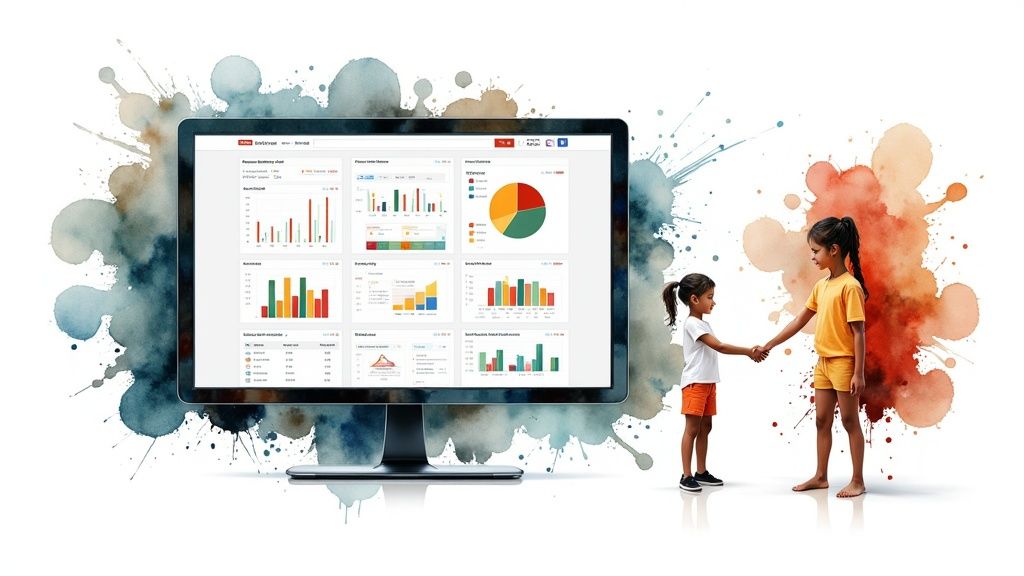




A balance point serves as an essential reference that shapes our understanding across many fields - from statistics to experimental research to financial analysis. This concept is particularly evident in statistics, where the mean acts as a central point where deviations on either side equal out. Put simply, in a dataset, the mean balances the values above and below it, similar to how a fulcrum balances a seesaw.
The mean does more than provide an average - it reveals key patterns in data distributions. For instance, when analyzing apple weights from a harvest, the mean weight helps farmers understand typical produce size. Tracking deviations from this central point can spotlight unusually large or small apples, helping identify growing issues or opportunities. This principle extends beyond agriculture - the mean serves as a reliable gauge for analyzing trends and making decisions across disciplines.
In research, balanced designs strengthen the validity of findings. This means having equal sample sizes across test conditions. Take a medical trial testing different drug doses - researchers aim for the same number of participants in control, low-dose and high-dose groups. Equal group sizes help ensure that any differences in results come from the treatment itself rather than sampling inconsistencies. While perfect balance isn't always possible due to real-world constraints, understanding how to handle imbalances properly remains crucial for drawing sound conclusions.
Economic analysts use balance figures on a -100 to +100 scale to measure market sentiment. Higher numbers suggest optimism while lower ones indicate pessimism. These measures, based on weighted survey responses, emerged in the early 1900s and remain vital tools. Organizations like the European Union regularly employ them to assess economic health and guide policy choices. This demonstrates how balance points help us understand complex systems at both micro and macro levels. For more insights, see: How to master data analysis with expert balance strategies.
In accounting, a "balancing item" reconciles differences between corresponding sides of an account to ensure accuracy. This basic principle underpins reliable financial reporting, as seen in frameworks like the System of National Accounts (SNA) 2008. Understanding these balancing mechanisms helps maintain consistency in financial records and enables meaningful economic analysis. Clear accounting principles built on balance create the foundation for sound business decisions and transparent financial oversight.

Balance figures, which range from -100 to +100, offer a precise way to measure market sentiment beyond simple positive or negative classifications. By examining these indicators in detail, analysts can better understand market dynamics and make more informed economic decisions.
A balance figure measures the gap between positive and negative responses in economic surveys, providing clear data about market conditions. For instance, when a balance figure shows +20, it indicates that 20% more respondents expressed optimism than pessimism about economic conditions. This detailed measurement helps economists assess market sentiment strength and puts other economic indicators into context. The consistent use of this metric since 1900, with projections extending to 2078, shows its enduring value in economic analysis.
Organizations like the European Union rely on balance figures to evaluate economic health and shape policy decisions. These measurements often signal upcoming market changes before they become apparent through other indicators. However, balance figures work best when analyzed alongside other key metrics like consumer spending, inflation rates, and employment data to create a complete picture of economic conditions.
Reading balance figures requires attention to multiple factors and context. Major changes in these numbers, particularly sudden shifts from positive to negative territory, often predict significant economic developments. For example, a rapid drop into negative territory might warn of an approaching recession. This insight helps companies plan their investment and hiring strategies. Each sector's balance figures need separate analysis since strong performance in one area doesn't always reflect the broader economy.
While balance figures provide valuable insights, they have specific limitations analysts must consider. One common error is placing too much weight on a single balance figure without examining other economic factors. Analysts should avoid making broad conclusions based on isolated data points. Survey responses that generate balance figures can be affected by participant demographics and current events, potentially skewing results. Understanding these limitations helps analysts use balance figures appropriately in their economic forecasting work.
This understanding of balance figures and their role in economic analysis helps investors, businesses, and policymakers make better decisions by properly interpreting market sentiment and its effects on economic patterns. By carefully considering these measurements alongside other economic data, decision-makers can develop more effective strategies.
The accuracy of scientific research depends heavily on precise measurements. Laboratory balances have evolved far beyond basic scales into sophisticated instruments that significantly improve research quality through built-in statistical capabilities. These advanced features allow scientists to collect and analyze data directly on the device, making workflows more efficient while reducing human error.
Today's balances, such as the Adam Equipment Equinox series, include powerful statistical tools that extend beyond simple weight measurements. These instruments calculate key metrics like minimum and maximum values, ranges between values, sums, and averages automatically. For example, when weighing chemical samples, researchers can instantly determine average weights to ensure experimental consistency. This eliminates manual calculations and minimizes transcription mistakes. The ability to calculate standard deviation right on the balance helps scientists quickly evaluate measurement precision and identify potential outliers requiring investigation.
Modern balances can store and retrieve data from multiple weighing sessions, effectively functioning as self-contained measurement databases. Consider a quality control lab checking product weight consistency - technicians can record hundreds of consecutive measurements directly on the device. The balance then analyzes this stored data to reveal weight variations across batches. This automated approach not only improves efficiency but maintains data integrity. With storage capacity for up to 500 consecutive weighings, as found in the Equinox balance, scientists can perform detailed statistical analysis on large sample sets right at the point of measurement.
One especially valuable feature is the automatic calculation of coefficient of standard deviation (relative standard deviation). This statistic expresses variability as a percentage of the mean, enabling direct comparisons between datasets regardless of their absolute values. Scientists can use this to evaluate different measurement methods or compare sample consistency across sources. By providing these analytical capabilities at the measurement source, modern balances help researchers produce more reliable results through improved data collection and analysis. The ability to examine statistics immediately during experiments leads to better research design and more robust conclusions.

Statistical accounting relies heavily on balance figures that ensure consistent and accurate financial reporting. These balancing items serve as critical checkpoints that maintain data integrity while providing valuable insights into economic activities. Let's explore how these elements work together to create reliable financial records.
A balancing item represents the numerical difference between two sets of account entries rather than a directly measurable value. When accountants subtract the total value of entries on one side (typically debits) from the other side (credits), the resulting figure serves as the balancer. For example, if total debits equal $100 and total credits are $80, the $20 difference becomes the balancing item. This calculation helps identify discrepancies and verify the accuracy of recorded transactions.
Complex accounting systems depend on balancing items to maintain internal consistency. Much like a keystone in an arch, these items hold the various components together and ensure the entire structure remains stable. For instance, the System of National Accounts (SNA) 2008 extensively uses balancing items across multiple accounts to produce reliable national economic reports. This framework demonstrates how balancing items support accurate financial data at both micro and macro levels.
Balancing items play active roles in various accounting scenarios:
These real-world applications show how balancing items provide meaningful economic insights beyond basic bookkeeping.
When balance discrepancies appear, accountants must investigate their source through careful analysis. Common causes include data entry mistakes, timing differences between transactions, or potential fraud. Resolving these issues requires reviewing source documents, double-checking calculations, and comparing records with external sources. Quick action on discrepancies ensures reliable reporting and supports informed business decisions.
Balancing items serve as valuable tools for understanding economic patterns and relationships. By studying trends in these figures across different sectors, economists can assess economic health and identify growth opportunities. This analysis, combined with other economic indicators, helps shape policy decisions and business strategies. The patterns revealed through balance analysis often highlight important market dynamics that might otherwise remain hidden from view.

A well-designed experiment is like a precision instrument - when properly balanced, it produces reliable results and clear insights. Just as a laboratory scale needs careful calibration, experimental design requires thoughtful planning to maximize statistical power and detect real effects. Getting this balance right from the start helps ensure your research yields meaningful conclusions.
At its core, balance in experiments means giving equal representation to different treatment groups or conditions. Consider testing three fertilizer types on crops - a balanced design would use the same number of plants for each fertilizer group. This equal distribution mirrors how a mean provides a centered reference point in data analysis. By minimizing the impact of outside variables, balanced designs help researchers confidently attribute observed differences to the treatments being studied. This principle holds true whether you're conducting marketing tests or medical research.
While perfect balance is the goal, real-world constraints often create challenges. Study participants may drop out unevenly, or resource limitations might prevent equal group sizes. Researchers can use several proven approaches to handle these situations:
Sometimes imbalances are unavoidable, but researchers can take steps to maintain study validity. One option is adjusting statistical analyses to properly weight data from differently sized groups. For example, using weighted averages ensures smaller groups still contribute proportionally to overall findings. Missing data techniques like imputation can also help restore balance by estimating values based on available information.
Success stories demonstrate balanced design in action. Take a clinical trial comparing blood pressure medications - researchers carefully match patient numbers and characteristics between treatment groups to draw reliable conclusions about the drugs' effectiveness. Similarly, website A/B tests split visitors evenly between old and new designs to accurately measure engagement changes. Whether studying plants or people, this fundamental principle of balance provides the foundation for trustworthy experimental results.
Understanding balance analysis requires examining how new technologies and methods are changing its application across different domains. By studying these developments, we can better adapt our analytical approaches for the future.
Artificial Intelligence and Machine Learning are reshaping balance analysis in significant ways. These tools can now process extensive datasets and detect subtle relationships that traditional approaches often miss. For instance, AI systems analyze market data from multiple sources, including social sentiment and economic metrics, to generate more accurate balance measurements. This improved precision helps organizations make better evidence-based choices.
Modern statistical platforms offer more capable tools for conducting balance analysis. These applications handle complex calculations automatically, which reduces errors and allows analysts to concentrate on interpreting results and developing strategies. For example, current laboratory equipment includes built-in statistical functions that provide immediate data analysis, improving scientific research accuracy. This advancement accelerates the pace of discovery.
Balance principles remain essential in experimental design, particularly when comparing different groups. Recent progress in statistical modeling helps researchers address real-world imbalances more effectively. Methods like propensity score matching and regression discontinuity analysis minimize the effects of uneven group sizes, supporting reliable experimental outcomes. These techniques expand research possibilities in complex settings.
As we adopt new analytical methods, maintaining high standards remains critical. When implementing these advances, we must carefully validate results using multiple approaches and understand each method's limitations. For example, relying only on AI-generated balance data without considering broader economic factors could lead to poor decisions. By combining technological capabilities with proven statistical methods, we ensure balance analysis stays accurate and meaningful over time.
Are you looking for tools to understand cryptocurrency markets better? Coindive provides essential project updates, market analysis, and AI-based insights to help inform your investment choices. Visit https://coindive.app to explore the platform's capabilities.